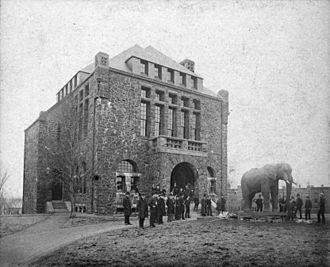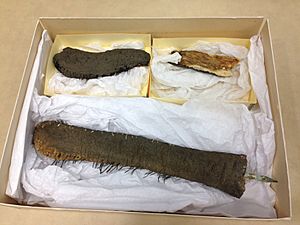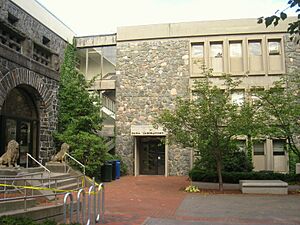Barnum Museum of Natural History facts for kids
Quick facts for kids Barnum Hall |
|
|---|---|

Barnum Hall
|
|
| Former names | Barnum Museum of Natural History |
| General information | |
| Type | Classroom, laboratory, museum |
| Architectural style | Romanesque Revival |
| Town or city | Medford, Massachusetts |
| Country | US |
| Coordinates | 42°24′28″N 71°07′15″W / 42.407787°N 71.120732°W |
| Opened | 1883 |
| Renovated | 1894, 1935, 1963, 1976 |
| Owner | Tufts University |
| Technical details | |
| Material | Blue-gray slate |
| Floor count | Three |
| Design and construction | |
| Architect | J. Phillip Rinn |
| Renovating team | |
| Renovating firm | Perry Shaw, Hepburn and Dean Kubitz & Pepi |
The Barnum Museum of Natural History was once a cool natural history museum at Tufts University in Medford, Massachusetts. It was started by the famous showman P.T. Barnum. The museum showed off amazing animals from his circus, like the preserved body of Jumbo the Elephant.
The building, now called Barnum Hall, was badly damaged by a fire on April 14, 1975. The fire destroyed everything inside. Luckily, the building was rebuilt and is still used today.
Contents
How the Museum Started
The idea for the museum came from Tufts University's President, Elmer Hewitt Capen. He wanted to make the university bigger and better. P.T. Barnum was a big supporter of the Christian Universalist faith, which had founded Tufts. So, President Capen asked Barnum for help.
In May 1883, Barnum agreed to give money for the museum. He wanted it to be a secret at first. But once his name was known, he said the building must "forever be called the Barnum Museum of Natural History." The new building was designed by architect J. Phillip Rinn. It was meant to look nice next to the Goddard Chapel on campus.
Building Design and Early Collections
The original museum building had two main floors and a basement. It included a laboratory for science experiments and a lecture room for classes. The ground floor had a library and an entrance area. The upper floors featured a huge hall, 34 feet high, where all the animal specimens were displayed.
The museum already had many items collected by Tufts University Professor John P. Marshall, mostly rocks and minerals. Also, Mary Goddard, an early supporter of Tufts, gave the museum a collection of coins, cultural items, and stuffed birds. For P.T. Barnum, this museum was one of many natural history collections he helped create for over 200 universities across America.
Museum Growth and Additions
After Barnum passed away in 1891, the museum continued to do well. Barnum had left another $40,000, which helped add two new parts to the building and new collections.
- In 1894, the university built the west wing. This new section included a biology lab, more classrooms, and another library.
- In 1935, an east wing was added for more labs and offices.
- The third addition, called the Dana Laboratory, was built in 1963. This big project cost $750,000 and was paid for by the National Science Foundation. The Dana Laboratory was named after Charles Dana.
The Big Fire of 1975
On April 14, 1975, a fire started in the building. It was caused by faulty wiring in a refrigerator on the second floor. By 4:30 in the morning, the building and everything inside were on fire. Firefighters from eight nearby towns came to help put out the blaze. By 6 a.m., the fire was under control.
Even though the fire was huge, no one was hurt. The building kept smoking for several days. When the smoke finally cleared, all that was left of the museum's collections were ashes and the metal frames that had held the animals upright.
Jumbo's Ashes
The morning after the fire, an employee went into the damaged building. They found what was left of Jumbo the Elephant and carefully swept his ashes into a small peanut butter jar. The news of Jumbo's loss became known around the world. It even overshadowed the loss of important research from the Biology department.
After the Fire
Today, Jumbo's ashes are kept in a special container. Sometimes, they are brought out to inspire the university's sports teams. Other small pieces of Jumbo's hide, like his tail, also survived the fire and are stored in the university's archives.
Rebuilding Barnum Hall
Plans to rebuild Barnum Hall started right away. Under President Jean Mayer, the university also worked to improve maintenance in other buildings to prevent future fires. The company Kubitz and Pepi was hired to rebuild the hall. However, the original sloped roof was replaced with a flat one. This change, along with the complete rebuilding of the inside, meant the building lost some of its original look.
In 1976, Barnum Hall reopened for students. Because the university's mascot, Jumbo, was gone, students placed a statue made of papier-mâché in his place. This statue had once been at a wild animal farm in New Hampshire.
Jumbo's New Statue
In 2013, a university group decided to get a new bronze statue of Jumbo. Steven Whyte was chosen to create it. The huge 5,000-pound statue was paid for by a former university leader. On April 27, 2015, the beautiful bronze statue of Jumbo was officially revealed.
Images for kids







